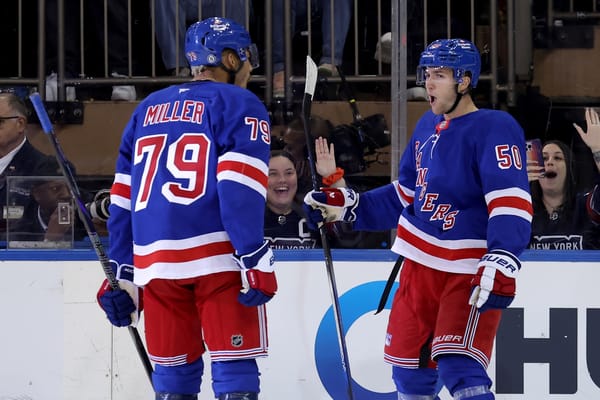The Key Components to the New York Rangers' Current Run
An improved breakout and transition game, low-event hockey, scoring chance generation/suppression, and winning loose puck battles, along with a healthy dose of the King, have all been critical components to the Rangers' stretch of 12 wins in 13 games. WARNING: this article is long. Hydrate and s
The Rangers came storming back from an early 2-0 deficit and then held on late to take a 4-3 decision from the Kings on Thursday night. It was an excellent win against an excellent opponent.
The shot attempt battle was tight throughout. If analysts merely focused on this, they might think that it was just a tightly contested game that the Rangers managed to win. They wouldn't be wrong, per se. However, that would not be giving credit to just how well they are playing, pure shot attempt differential analysis aside. It would also only scratch the surface of what has truly catapulted the Rangers into the upper echelon of the NHL this season after their early struggles.
The Rangers were able to get the better scoring chances, and bounces, that they needed against the Kings to exorcise some of the demons lingering from the end of last season. While the Kings are a superior opponent who pushed them to the brink of breaking early in the game, the Rangers eventually beat them with the same approach they have been using for well over a month now:
- Play low event hockey that reduces opposing quality scoring chances by collapsing quickly on shooting lanes in the zone and taking away laterally transitioning play opportunities
- Control transition play
- Generate high quality scoring chances
- Win loose puck battles at a high rate
- Produce on the power play/
Low-Event Shot Attempt Differential
Since the current run of 12 wins in 13 games began, the Rangers have limited opposition to just 44.3 5v5 score-adjusted shot attempts against per game (SA CA/60), good for third lowest in the NHL, only trailing the Red Wings and Kings.While they aren't generating a ton of shot attempts going the other way (52.7 SA CF/60), the differential of 54.4% SA CF% is 7th best in the NHL during that time.
The shot attempt differential chart above from the Rangers win over the Kings (5v5 Score-Adjusted Corsi) certainly paints a picture of a tightly contested, low event game. And it was, with just 40 NYR 5v5 CF, and 45 LAK 5v5 CF.
Notably, John Moore had his second strong game in a row. He was +11 in 5v5 shot attempt differential (79%) leading all Rangers. He was +14 (72%) against the Ducks to lead all Rangers as well. Turning a corner? It is possible. I'll leave analyzing improvements in his game for another article.
Scoring Chance Suppression
Yes...Rangers goaltending has been absolutely nails since November 1st. We know this. They have had the second best 5v5 sv% in the league during that time (93.4%) and the 4th best overall sv% (92.3%). Only Jaroslav Halak and Ben Bishop have had a higher sv%H (save percentage on shots from high scoring probability areas) than Lundqvist's 86.26% amongst goalies with 15+ starts during that time (loosely defined as starters).
But only since early December have the Rangers been playing a low event, "safe" brand of hockey in their own zone that has limited high quality scoring chances. This has been the hallmark of their current run. Over the past 13 games they have suppressed and defended against scoring chances better than any team in the NHL, giving up on average just 18.2 5v5 scoring chances against per 60 minutes (SCA/60).
For a definition of scoring chances please visit War-On-Ice.com.
This is in stark contrast to the start of the season through the end of November, where they gave up 25.3 SCA/60, which, combined with numerous defensive gaffes borne from poor zone exits, and atypical Lundqvist netminding, led to a middling 11-9-4 record through the end of November.
Against the Kings it was more of the same success they have sustained for a while now, albeit against a tougher opponent. The Rangers won the scoring chance battle 25 to 21. A closer look at where the Rangers pushed a lot of shots to, and how many shots the Kings missed in high probability areas, further reveals what your eyes may have told you while watching. The Rangers were hounding the top-end producers for the Kings in-and-around the slot. They consistently forced shots to the outside or, in the least, contested the Kings scoring chances, limiting laterally transitioning play in the high-probability areas.
The Kings managed 12 5v5 shots on net from the premium ice I have outlined above, and were consistently contested when taking the puck into those areas. The Rangers did a great job of pressuring shooters into take what Steve Valiquette has coined as "red shots" that do not cross the "Royal Road," which is the vertical center line drawn on the chart above. According to Valiquette, red shots that do not transition laterally across the middle account for just 24% of all NHL goals. 11 of the Kings 12 scoring chances on net were red shots. In fact, their first goal was the only "green shot," that crossed Royal Road. By pressuring shooters and taking away time and space, the Rangers greatly reduced the likelihood of goals against. This has been a consistent feature of their DZ play recently.
The Kings' offense was largely predicated on in-zone possession time and not rush transition chances, thereby reducing the instances where Cam Talbot was forced to telescope and transition laterally to make saves without being set for the shot. In fact, the Kings only two quality rush chances that generated shots on net from the high probability area above were their first two goals.
Further, the Rangers only allowed one 5v5 individual scoring chance (iSC) each from the likes of Marion Gaborik, Anze Kopitar and Justin Williams, as well as just 2 from Jeff Carter. Over the past month, Gaborik and Carter have been one and two in the NHL in SCF/60. So that is no small feat. Williams' chance was the second goal, a slap shot from the top of the circle that Talbot was square for and should not have let in.
Controlling Transition Play
The Rangers Corsi Pace per 60 is closer to Detroit and New Jersey (98.7%, T-4th lowest) than it is the chance trading team you might expect, given their speed and stretch-passing for quick outlet transitions.
Rangers assistant coach Ulf Samuelsson is excellent. I have sung his praises before and I truly believe he will be an NHL head coach very soon. He has been a key architect in helping the Rangers to improve the cleanliness of their zone exits and make best use of their team speed. Take a look at this video:
The Rangers exit cleanly with centers supporting defensemen deeper in the defensive zone to create a consistent numbers advantage and options to get the puck off the boards and into the hands of a player in the middle of the ice who can make a head-man pass early. Puck carriers have multiple options around them because all five skates are engaged as release valves for pressure on the puck carrier. Breaking wingers are getting up ice with speed for rush chances or safe chip and chases into the offensive zone. When they have nothing, the support moving up ice allows puck carriers to reset using their D as a backwards passing option. This is all reminiscent of Mike Babcock coached Detroit Red Wings teams.
Once offensive zone entry is achieved, the Rangers then limit their exposure to transition coming back the other way by rarely being caught with more than 2 guys below the goal line. They instead stagger their forecheck, utilizing suffocating individual closing speed to frustrate puck control and exit passes. This individual speed frees up other skaters to take away outlet lanes. They thereby cause additional turnovers leading to broken play scoring opportunities in premium ice. When the Rangers do not have a clear lane to the loose puck, they favor backing off and maintaining numbers in an aggressive backcheck, which prevents odd-man transitions against them.
The combination of these two transition characteristics limit the total events, but heavily favor the Rangers, who control transition pace and rarely let the game get away from them.
Creating High Quality Scoring Chances For
The Rangers are producing quality scoring chances attacking the middle of the ice in the low and high slot. The high probability, or high danger, scoring areas. But more specifically, their playmakers are making strong laterally transitioning setup passes to shooters in and around those areas. The strong support transition game has buoyed their quick attacking forwards. They have entered the zone in control and with speed, or been able to chip the puck past defenders and reach it before the opposition has a chance to set their defense, or even turn to retrieve the puck.
Take a look at where the Rangers are generating most of their 5v5 shot attempts of late. This is Thursday's game against the Kings:
The Rangers produced 10 of Valiquette's "green shots," at 5v5 out of 14 chances that hit the net. These are premium scoring chances cutting through the middle ("Royal Road") of the high probability low and high slot. They also produced several such chances on the powerplay, resulting in a goal.
Such attempts force goaltenders to fight off shots while moving, and while dealing with traffic in front of them, with very little time to react, square up or set themselves. The resulting movement also creates screens, tips, deflections, rebounds and, generally, havoc around the net ,even when the goaltender does make the save or the attempt is blocked or misses. Lee Stempniak's go-ahead 5v5 goal was an example of the type of laterally transitioning movement that gives even aggressive first-shot goaltenders like Jonathan Quick fits.
Notice on that goal that Quick had to move with the shooter, fighting through traffic. He never was set to make a save prior to the shot. The sheer congestion in these situations alone is incredibly problematic for goalies.
Further, it favors the staggered attacking team, as defenders are spinning to make coverage decisions and play is firmly in front of the offense. The Rangers employ a 1-2-2 or passive 2-1-2 allowing them to read and react to play in front of them, and quickly recover loose pucks. I will discuss this below.
While the Rangers have not been producing scoring chances for at a particularly high rate during their current run, they've been playing a safer and lower event brand of hockey overall which has led to a solid 54.4% SCF%, good for 8th in the NHL during their current 13 game run. As shown above, they have also been particularly opportunistic on the chances they do get. Benefitting from above average setup passers like Mats Zuccarello and Derek Stepan, several of their better finishers have been able to consistently force laterally transitioning plays around the net for high quality chances. During the run, Zuccarello has increased his shot rate to 34.3 5v5 SF/60, highest amongst forwards. His 5v5 sh% during that time has been 15.8%. Similarly, Nash, Miller and Hayes are up over 12% and doing the majority of their finishing right around the front of the net, where it is most likely to be at least reasonably sustainable.
The reality is that given the quality of the Rangers' chances against the Kings, this game was not as close as it seemed, and could have been a more lopsided score if not for several acrobatic sprawling saves by Quick.
Winning the Loose Puck Battles
By winning loose puck battles not with numbers, but with high end closing speed on 50/50s (loose pucks engaged by an equel one-to-one, two-to-two etc ratio of players), the Rangers have freed up supporting skaters to get into high probability scoring lanes. This has forced opposition to play them honestly around the slot area, giving the puck carrier more space and time.
In the interest of full disclosure, my manual game tracking data for this current run is not entirely complete. However, of what I have tracked, the Rangers have been able to win such battles in the offensive zone at a 66% rate for stretches of this run. That is a substantial differential that can be largely credited to fast and supported transition, followed by excellent in-zone individual closing speed on those loose puck chances.
The Ducks and Kings were consistently spun around in their own zone by the Rangers top-end closing speed and either coughed up poor exit passes or gave up on chasing loose pucks outright. They instead fell back and congested the middle as the Rangers forwards ran roughshod through the slot area.
The result? Screening your own goalie as Rangers players transition play right through the slot for screened shot attempts. Take a look at these two goals from Thursday night's game, scored 19 seconds apart:
Hockey 101 Pro Tip: While shot blocking is a skill that does have a place in the game, you don't want to do the opposition's work for them by screening your own goalie and deflecting pucks that he might otherwise get a clear look at.
As I continue to grow my manual tracking database, it is becoming more and more clear that the team that wins the loose puck battle differential convincingly is winning most games. This isn't earth shattering news for players and teachers of the game. It is a time-honored focal point proven in the data. The Rangers are doing just that, and it is contributing to their success.
The Power Play Has Come Alive
The Rangers power play production has had a remarkable turnaround of late. I'll leave in-depth analysis of the hows and whys for another article, as we are getting up around 2000 words here. But it is noteworthy that during the Rangers run of success they have led the NHL in PP shots for per 60 minutes (68.6) and trail only St. Louis in PP Goals For per 60 minutes (13.5). Their PP sh% has been at 19.7%, 3rd best in the NHL. Like I said, I'll leave analyzing the hows and whys for another time. But suffice it to say, this has helped increase the team's overall goals for and goal differential quite substantially.
Is This All Sustainable?
Putting aside the power play and focusing only on 5v5 play, the Rangers' performance of late appears to me to be entirely sustainable. This isn't flukey or lucky stuff resulting in wins. The Rangers are playing an excellent brand of 5v5 hockey right now which is tailor-made for their best attributes of speed, team-supported transition, and high-end scoring talent getting to high-probability scoring areas. The results of late have been overwhelming and of course it would not be reasonable to think that they can continue at a pace of winning 92% of their games. But, barring injuries, they can absolutely sustain the type of play they have benefitted from lately over a longer stretch of time, and likely continue to get elite goaltending from Henrik Lundqvist, as is tradition.
And in case Rangers fans needed even more reason for optimism, this low-event style of play should serve them exceedingly well come playoff time.
Stats and charts used in this article were compiled from war-on-ice.com and hockeystats.ca.




